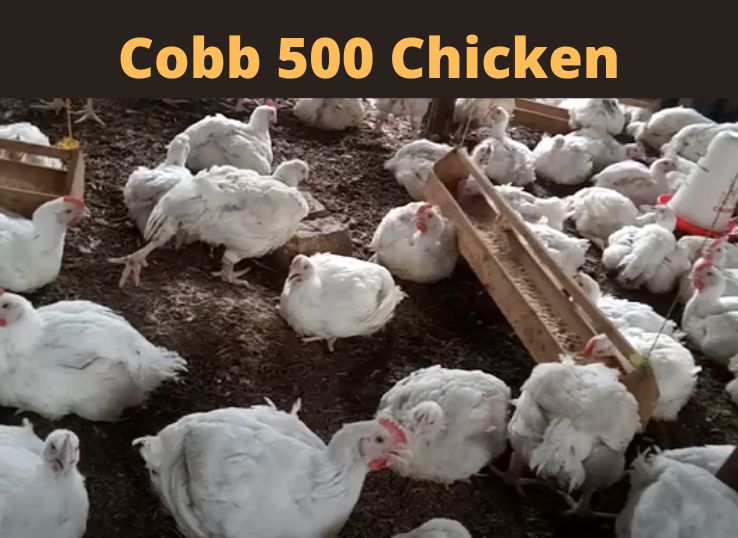Last Updated on August 3, 2023

Choosing a hybrid broiler chicken breed is the staple of generating farm profits. Cobb 500 chicken is considered the most production-efficient broiler chicken in the whole world. Cobb-Vantress is the company behind the development of Cobb 500 chicken.
Cobb 500 chicken offers prolific live-weight production of 2 kg in 6 weeks period. The ‘Cobb-Vantress’ is the oldest poultry breeder company to develop feed-efficient broiler breeds. Cobb 500 chicken is one of their top-notch products chickens.
A survey conducted on per capita meat consumption gives us some interesting data. According to that, 96.4 pounds of broiler meat is consumed in 2020 per capita in the US. There is also a future prediction stating that the per capita consumption will be increased to 101.1 pounds by 2030.
In my opinion, rearing Cobb 500 chickens on a commercial poultry setup is going to be a profitable deal. This article is going to shed light on the complete knowledge regarding Cobb 500’s production & efficiency.
Table of Contents
ToggleCobb 500’s History & Development
The Cobb 500 chicken breed was initially bred and developed in the 1970s. Not only the breeders but also retail sellers saw Cobb 500’s potential in terms of meat production. After the initial development of this breed in England, Cobb 500 finally came to the US.
The breeding plan in the initial development was focused on maximum breast meat production. The Cobb 500 was considered 5 times more efficient than Cobb 100. The name of this breed was devised by Robert Cobb.
By 1980, there was a significant amount of work done in the development of the Cobb 500. In 1982, Cobb 500 was introduced in the US after a joint venture between Tyson foods and Arkansas Breeders.
In today’s world, Cobb 500 tops in the ranks of the most efficient broiler breeder throughout the world. The Cobb research genetics combined with excellent meat production is the base of Cobb 500 chicken.
Physical Features of Cobb 500 Chicken
You often see broiler chickens in some of the generic colour patterns. Cobb 500 is entirely covered with white feathers over the body. The tail and heads of males and females are also white in appearance.
The comb and wattles are pinkish red, and the ear lobes are white. Cobb 500 chicken has a single-type comb on the head. The beak and legs of this breed are yellowish in appearance and don’t contain any feathers extending down to the feet.
On defeathring, you can see the yellow skin colour of the Cobb 500 chicken. As this breed is specifically developed for meat purposes, their body contains an excellent meat-to-bone ratio. Their breast is very well developed with a good breast mass.
Growth Performance & Weight Gain
Cobb 500 chickens offer several competitive advantages over other broiler breeds. These chickens have a very good feed conversion ratio. What it means is that Cobb 500 can convert the feed into meat at an extremely efficient rate.
Due to low FCR, these chickens have shown an excellent growth rate. The real-time feed conversion technology is devised during the breed development of the Cobb 500. This breed is now able to gain weight of 2 kg in a short 6-week period.
The gain of this much weight in such a small amount of time makes this breed the most efficient one. This will enable the chicken owners to save a lot of feeding costs. The chickens are also capable of gaining live market weight in a shorter time frame.
Another advantage of keeping Cobb 500 is its low-density feed conversion. This breed is known to provide fruitful results even on a cheaper feed. The productivity and uniformity of Cobb 500 stay consistent no matter what kind of climatic conditions they live in.
Temperament & Robustness
Cobb 500 chickens are very docile and they don’t move around much. They can easily be accommodated in environmentally controlled and conventional sheds. As these chickens are efficient in gaining weight, they are not free-ranging and rely on commercial feeds.
Cobb 500 has a good record of robustness and environmental tolerance. The development doesn’t only just focus on weight gain but also on stress reduction. They can easily adapt and react to environmentally induced stress factors.
Rearing Guidelines for Cobb 500
All commercial poultry breeds require proper managemental care regarding housing and feeding. All of the important rearing parameters, such as ventilation, cleaning, and stocking density, must be kept in focus.
Regarding housing management, Cobb 500 chickens require a properly arranged housing system. The chicks must be taken care of using the recommended temperature and humidity settings.
In housing management, proper checking of the litter material, feeding equipment, & fan management must be done. Cleaning and Sanitation using disinfectants and use sheets around the farm are recommended by experts.
The nutritional management of Cobb 500 is employed using ingredients that provide quality nutrition. The components such as amino acids, water, vitamins, and minerals help a lot in accelerating growth rates.
The feeding of chicks and adults is quite different from each other. Cobb 500 chicks required a formulated feed of 20% Crude Protein. Besides, the CP ratio of adult feed must be set to 16% to 18%.
You can also use supplemental whole wheat feeding to fulfil the requirement of metabolizable energy. The supplementation of pre-added coccidiostat is important to prevent your broilers from getting coccidiosis.
Final Thoughts
Cobb 500 chicken has the potential to gain weight faster at the lowest feed expenses. These birds can grow and attain a weight of 1.8 to 2 kgs in a 6 to 7 weeks period. If you’re someone who wants to raise a meat-purpose breed, Cobb 500 chicken is your best bet.
This breed is developed by Cobb-Vantress and is being widely used throughout the world. Cobb 500 is completing the meat consumption requirement of the human population. With proper management, these birds add excellent profits to broiler farming setups.
Research References
Lacy, Michael P. “Broiler management.” Commercial chicken meat and egg production. Springer, Boston, MA, 2002. 829-868.
Corzo, A., et al. “Responses of Cobb× Cobb 500 broilers to dietary amino acid density regimens.” Journal of applied poultry research 19.3 (2010): 227-236.
Marcu, Adela, et al. “The influence of genetics on the economic efficiency of broiler chickens growth.” Animal Science and Biotechnologies 46.2 (2013): 339-346.
Ramaphala, Oscar. Effect of egg weight on hatchability and chick hatch-weight of COBB 500 broiler chickens. Diss. 2013.

I am a Veterinarian by profession having 3 years of experience in raising poultry flocks. So far my number of successful flocks is 9. I am sharing all my experience about poultry farming with you so that you can make this profession your bread and butter. Stay Tuned with my latest post.
